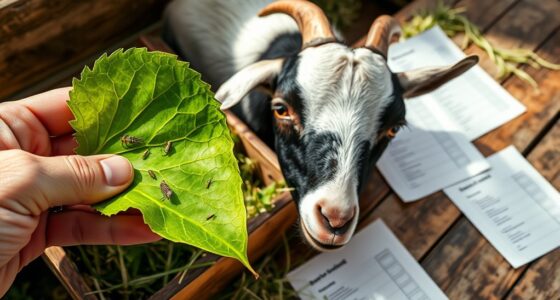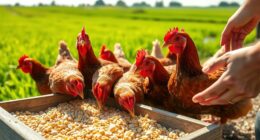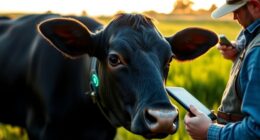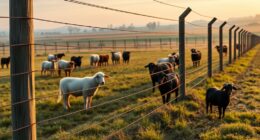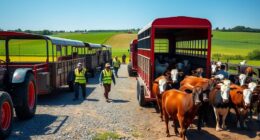To set up a farm biosecurity plan that effectively prevents disease, start by evaluating your animals’ health, ages, and farm layout to identify risks. Establish controlled access points, enforce visitor protocols, and provide proper sanitation measures, including routine cleaning and disinfection. Manage animal movements carefully with quarantine procedures for newcomers, and train your staff regularly on biosecurity practices. By implementing these steps, you’ll greatly reduce disease spread—continue to explore how each element can work best for your farm’s unique needs.
Key Takeaways
- Assess farm-specific risks by evaluating animal health history, regional threats, and environmental contamination sources.
- Establish controlled access points, implement visitor screening, and designate visitor areas to limit disease introduction.
- Develop routine sanitation protocols for cleaning equipment, surfaces, and waste management to reduce pathogen spread.
- Enforce quarantine procedures and detailed record-keeping for new animal introductions to prevent disease transmission.
- Train staff regularly on biosecurity practices, monitor compliance, and foster a culture prioritizing disease prevention.
Assessing Your Farm’s Risks and Needs
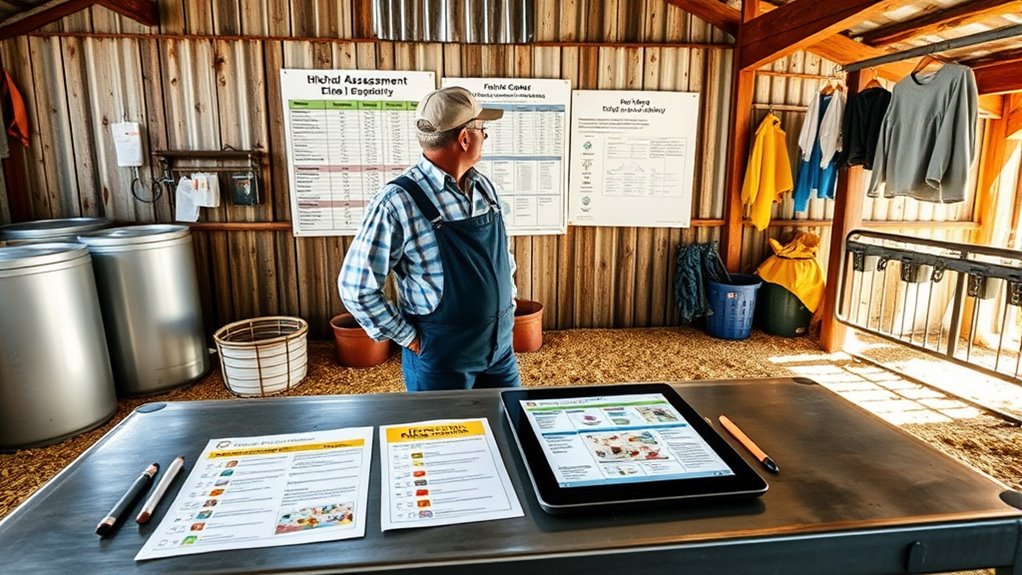
Before developing a farm biosecurity plan, you need to identify the specific risks and needs of your operation. First, evaluate the types of animals you keep, their ages, and health histories. Consider nearby farms, wild animals, and potential sources of contamination, like feed suppliers or equipment. Pay attention to common disease threats in your region and any recent outbreaks. Assess your current practices, such as cleaning routines, storage, and quarantine procedures. Understand your farm’s layout to identify vulnerable points for disease entry. Recognize the movement patterns of workers, visitors, and vehicles. Additionally, understanding the role of biosecurity technology can help you implement more effective measures. This thorough assessment helps you pinpoint weaknesses and prioritize actions, ensuring your biosecurity measures are tailored to effectively protect your farm from disease risks.
Establishing Controlled Access and Visitor Protocols

To effectively prevent the introduction of diseases, you must establish strict access controls and clear visitor protocols on your farm. Limit entry points and keep them well-marked to prevent unauthorized access. Require visitors to sign in and provide contact information before entering. Implement a visitor checklist that includes health screenings, such as asking about recent contact with sick animals or travel history. Designate specific areas for visitors, away from animal housing, and instruct them on proper behavior, like avoiding contact with animals unless authorized. Ensure all visitors wear farm-provided clothing or footwear, and provide hand sanitizers at entry points. Regularly review and update these protocols to adapt to changing circumstances, ensuring everyone understands their role in maintaining farm biosecurity. Incorporating mindful decluttering strategies can help keep access points clear and organized, reducing potential hazards or confusion.
Implementing Effective Sanitation and Disinfection Procedures
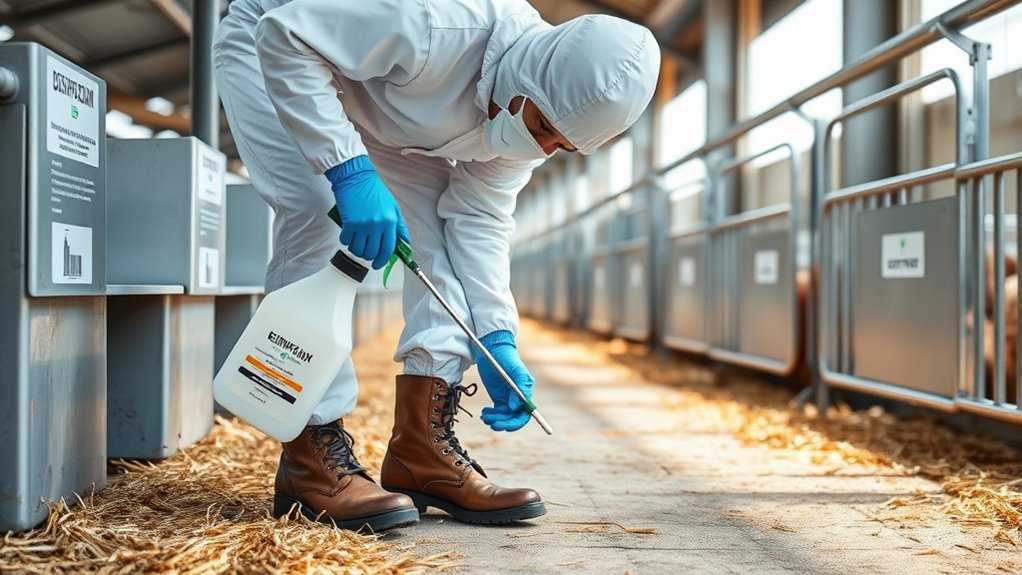
Effective sanitation and disinfection are crucial for preventing the spread of disease on your farm. You must regularly clean and disinfect all equipment, tools, and surfaces that come into contact with animals or their environment. Use appropriate cleaning agents to remove organic matter, which can hinder disinfectant effectiveness. After cleaning, apply approved disinfectants thoroughly, ensuring all high-touch areas, feeding equipment, and housing surfaces are covered. Pay special attention to door handles, waterers, and shared tools. Develop a routine schedule for sanitation procedures and train staff to follow it consistently. Proper disposal of waste and soiled materials is also essential to avoid contamination. By maintaining rigorous sanitation and disinfection protocols, you considerably reduce the risk of disease outbreaks and promote a healthier farm environment.
Managing Animal Movements and Quarantine Practices
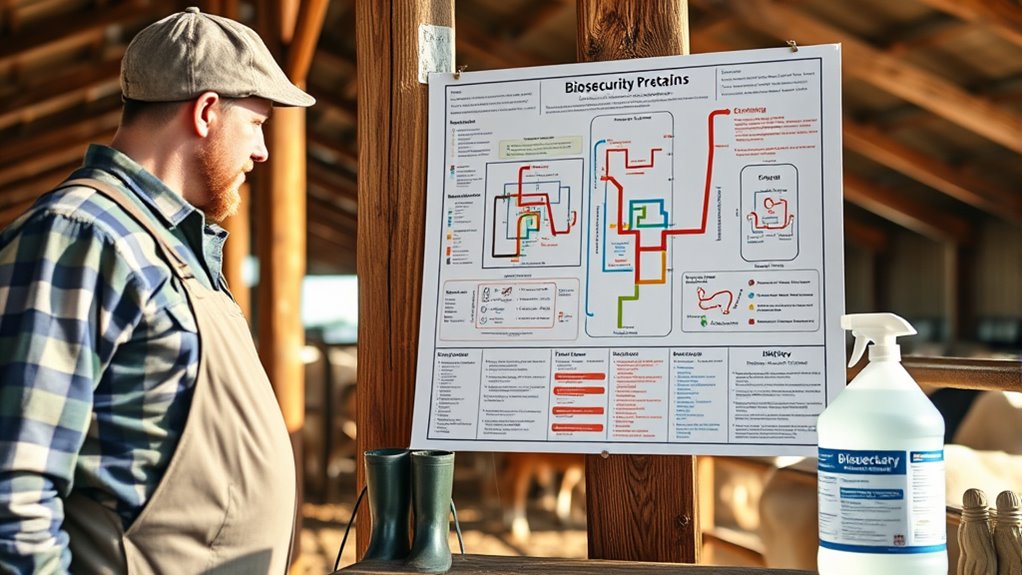
Managing animal movements and quarantine practices is essential for safeguarding your farm from disease introduction and spread. You should carefully control the movement of new animals onto your farm, ensuring they come from reputable sources with good health records. Implement a quarantine period for all incoming animals, typically 30 days, during which you monitor them for signs of illness. During quarantine, isolate new arrivals from the rest of your herd to prevent potential transmission. Keep detailed records of animal movements, including dates, sources, and health status. Limit unnecessary movements within your farm, and plan transportation to minimize stress and contact with external animals. Proper storage of animal products and ensuring that feed and bedding are clean and uncontaminated further help prevent disease transmission. These practices help prevent the entry and spread of diseases, protecting your herd’s health and productivity.
Training Staff and Monitoring Biosecurity Compliance
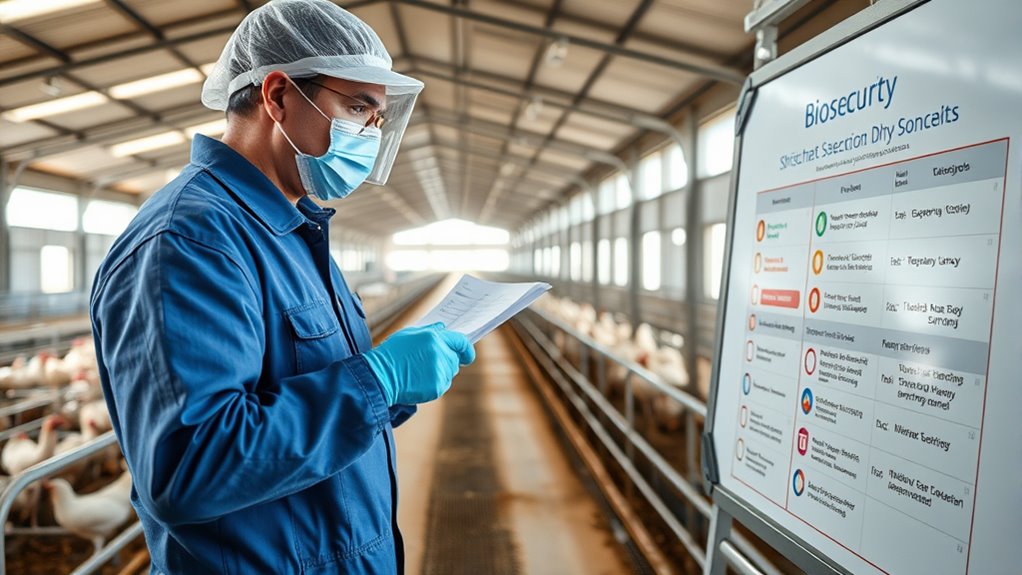
Training staff and monitoring biosecurity compliance are critical steps in maintaining a secure farm environment. You need to guarantee everyone understands their role in preventing disease spread. Start by:
- Conducting regular training sessions to keep staff updated on biosecurity protocols.
- Clearly communicating expectations and procedures through written materials and meetings.
- Observing staff behavior daily to ensure proper practices, like handwashing and equipment cleaning.
- Keeping records of training and compliance checks to identify areas for improvement.
- Reinforcing the importance of biosecurity measures regularly to foster a culture of safety and responsibility.
Frequently Asked Questions
How Often Should Biosecurity Protocols Be Reviewed and Updated?
You should review and update your biosecurity protocols at least annually or whenever there’s a change in farm operations, new disease threats, or after an incident. Regular reviews help guarantee your measures stay effective and relevant. Additionally, involve your team in these updates to identify any gaps and reinforce best practices. Staying proactive and adaptable is key to keeping your farm disease-free and maintaining healthy livestock.
What Are Common Biosecurity Mistakes to Avoid?
You should avoid common mistakes like neglecting to restrict visitor access, which 60% of farms overlook, increasing disease risk. Don’t forget to properly disinfect equipment and footwear; failure here can spread pathogens quickly. Also, don’t ignore staff training, as 70% of outbreaks start due to human error. Regularly review and update your biosecurity measures to stay ahead of potential threats. Staying vigilant helps protect your farm’s health and productivity.
How Can Biosecurity Measures Be Adapted for Different Farm Sizes?
You can adapt biosecurity measures by tailoring protocols to your farm’s size. For small farms, focus on strict visitor controls and sanitation, easily manageable for fewer animals. Larger farms need extensive strategies, like designated zones and rigorous vehicle disinfecting. Implement scalable procedures, ensuring all staff understand and follow them consistently. Regularly review and adjust your measures to address evolving risks, balancing thoroughness with practicality to protect your entire operation effectively.
Are There Specific Biosecurity Practices for Organic Farms?
Yes, organic farms should focus on practices like restricting access to essential personnel, using sanitized equipment, and avoiding synthetic chemicals that can disrupt natural defenses. You should prioritize natural pest control and composting to reduce disease risks. Regularly monitor animals and crops for signs of illness, and practice strict hygiene when handling organic inputs. These practices help maintain the integrity of your organic system while effectively preventing disease spread.
How to Handle Biosecurity During Emergency Disease Outbreaks?
During emergency disease outbreaks, you should isolate affected animals immediately and restrict access to essential personnel only. Clean and disinfect equipment, footwear, and hands thoroughly before entering or leaving the farm. Notify local authorities and follow their guidance. Keep detailed records of all movements and actions taken. Communicate clearly with your team, emphasizing the importance of strict biosecurity measures to contain the outbreak effectively and prevent further spread.
Conclusion
By following these steps, you create a strong defense against disease and keep your farm healthy. Think of biosecurity as a shield, much like a well-tuned alarm system that detects threats early. When you stay vigilant, control access, and train your team, you reduce risks and support your animals’ well-being. It’s not just about prevention — it’s about building a resilient farm that can thrive despite challenges. Your proactive approach makes all the difference.




